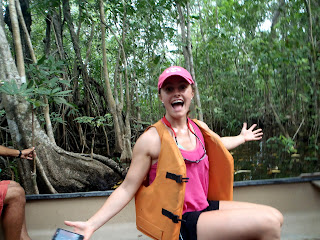As Lindsey has commented, we only get the weird turtles. Actually, this is quite possibly the second false crawl for this particular turtle, as we had a female come up just after we left the beach last Wednesday who also wandered around in the bushes digging holes without any visible nests being laid.
My favorite part of the evening? Getting to wrestle the turtle. Basically, even though it was a false crawl, we needed to flipper tag the turtle--something that is much easier to do while she is burying her nest and not trying to actively escape you. In this case, the turtle was bee-lining (well, as fast as a marine turtle can) back to the ocean. Keep in mind that these turtles are about three feet long and more than two feet across. They also weigh almost as much, or more, than I do. Holding one down takes a lot of work. Both Chel (BICA employee) and I were holding onto this one together as Lindsey placed the metal tag on the inside scale of the right flipper. This is very similar to the ear tags you often see on cows, but it takes a bit more force to get the tag set through the tough keratin of the turtle scale.
Between having to reset equipment to prep for the next turtle (Lindsey has to have a new set of data loggers for each nest) and the pouring rain that was blowing in at regular intervals (we were pretty much soaked, even in our rain gear), Lindsey decided to call it a night. We not only got to see a turtle, but we get almost a full night's sleep too! Score! It's a good day.























